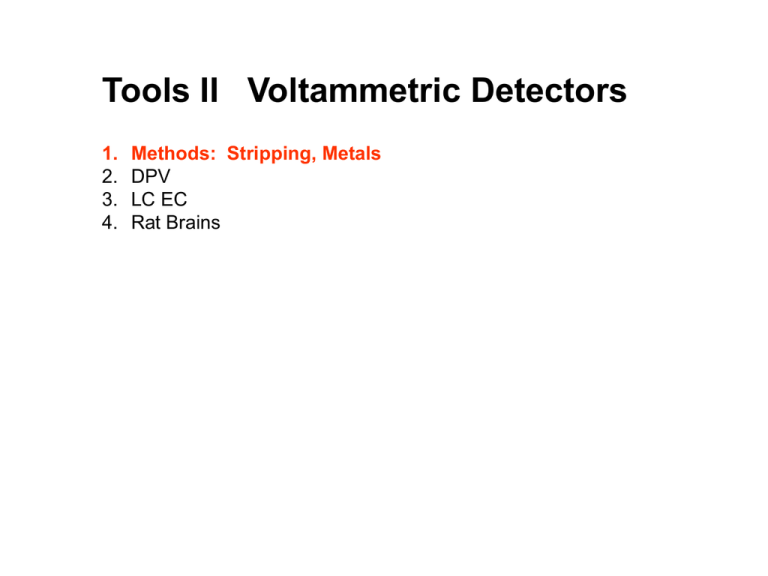Tools II Voltammetric Detectors 1. Methods: Stripping, Metals
advertisement

Tools II Voltammetric Detectors 1. 2. 3. 4. Methods: Stripping, Metals DPV LC EC Rat Brains Anodic Stripping Voltammetry 1. General Process 2. Hanging Mercury Drop Electrode (HMDE) 3. Mercury Film Electrode 4. Non-mercury Electrode 1. Some electrode surface that forms an alloy with metals,OR, which catalyzes deposition 2. Preconcentrate metal by reducing from large volume into the alloy 3. Strip with an anodic sweep to oxidize from the alloy Coulombs N moles nelectrons id t d mole moleelectron s t d moles C * M id t d 4 3 nF ro 3 Deposition current And time of deposition Concentration in the drop HMDE, spherically shaped ro 5 1/ 2 0 . 725 x 10 nD M 1/ 2 * 5 3/ 2 1/ 2 i p AD M C M 2.69 x10 n ro Compare to the Randles-Sevich Equation: 1/ 2 1/ 2 * i p 2.69 x105 n 3/ 2 ADox Cox For a Mercury Film Electrode the rate of arrival of the metal atoms at the surface For oxidation is altered due to the geometry of the electrode 2 2 n F v AC ip 2.7 RT * M Compare to the peak for voltammetry at a thin layer electrode: n F VC i 4 RT 2 Because the current at a thin film Electrode is of the same class as p Current at a thin film, the peaks drop To baseline, resulting in better deiscrimination of Metals with similar potentials 2 0 Figure 11.8.6 bard and faulkner Tool II Voltammetric Detectors 1. 2. 3. 4. Methods: Stripping, DPV Metals LC EC Rat Brains Goal to use the electrstatic attraction for accumpulation Similar goal in using Nafion – also anionic material easily manipulated , H.; Kim, Y. S.; Einsla, B. R.; McGrath, J. E. Chem. Rev. 2004, 104, 4587. (b) Haile, S. M. A Note the selectivity in potential and the discrimination between various metals Makes use of the enhanced microscopic surface area and electric fields of the JChem Ed 2007 Tool II Voltammetric Detectors 1. 2. 3. 4. Methods: Stripping, DPV Metals LC EC, LC EC MS Rat Brains Many organics are easily oxidized absolute value m -3 -2.5 -2 E vs SCE -1.5 -1 -0.5 0 0.1 0.2 0.3 0.4 0.5 0.6 0.7 0.8 0 0.5 1 1.5 2 Most solid metal electrodes do not oxidize in this range and so have low background current Many others are easily reduced All are candidates for voltammetric analysis Signal to Noise in Voltammetric Analysis The limit of detection (LOD) is often defined as 3xpeak to peak signal due to noise “Noise” in voltammetric methods is the result of 1. Competing or background electron transfer events originating in the a) Solvent b) Surface 2. Currents arising from charging of the electrode surface The limit of detection is also affected by distortion of the signal due to IR error Solutions to the IR and Capacitive Current Problems 1 C C i nFAD nFAD 2 1 Dt t 2 icapacitive E exp Rs t Rs C Signal Background These are on two different time scales! Modulate the time domain of the experiment to discriminate against capactive currents. Square Wave Voltammetry 1 cycle E tp 1 2 2Epulse ip nFACO* D O t p p Estep p dim ensionless peak current t Kissinger Bard AC Voltammetry 0.3 0.2 0.1 0.2 0.1 E -0.1 0 -0.1 Ac perturbation -0.2 -0.3 -0.2 0 50 100 150 200 250 300 350 400 450 Time -0.3 0 50 100 150 200 250 300 350 400 450 0.3 Time 0.2 0.1 DC sweep E E 0.3 0 0 -0.1 E -0.2 -0.3 0 50 100 150 200 250 300 350 400 450 AC Voltammetry 1/ 2 nF D RT R 2 o E dc E 4 RT cosh ln 1/ 2 nF DO RT Ip n 2 F 2 A 1/ 2 Do CO* E 4 RT w 64 49 35 25 16 I I n 2 F 2 A 1/ 2 Do CO* E -0.3 -0.2 -0.1 0 Edc 0.1 0.2 0.3 Differential Pulse Voltammetry exp nFA Do CO* ' I t 1 1 ' Want i max nf E E o exp ' exp nf E E E o i i i i ' nFA Do CO* 1 ' 1 DO DR E E f E 2 i ' t Summary 0.3 0.2 AC voltammetry Ip 2 1/ 2 Do C E * O 4 RT 0.1 E n F A 2 0 -0.1 -0.2 -0.3 0 50 100 150 200 250 Time DP Voltammetry SW Voltammetry i max ip nFA Do CO* 1 1 ' nFACO* D O t p p 300 350 400 450 GCE LC EC Control xD at a fixed distance: Rotating Disk electrode, RDE Wall Jet Electrode, WJE RDE WJE D 13 16 x D 161 . 1 2 1 5 1 5 3 D 3 12 a 2 x 4 x D 0.986 4 3 4 V kinematic vis cos ity angular velocity electrode 2f (1 / s) f rotation rate of electrode r electrode radius (cm) x dim ension along electrode surface from jet a jet orifice diameter (cm) V velocity of propelled solution (ml / s) Glassy Carbon Electrode CFME= Carbon Fiber Microelectrode Poly(3-methylthiophene) (P3MT) Bare=dotted lines Set as Eapp Point is that the peak is lost under flow conditions, so that the selectivity is lost Set as Eapp Point is that the peak is lost under flow conditions, so that the selectivity is lost LC EC MS Some analytes are poorly suited to MS because of the difficulty in the ionization Pathway. P-chloroaniline (CPA) is one example Anticarcinogen sulofenur Another way to get Ions for the mass Spec is to allow Electrochemical Reactions with donors And or acceptors TMPD can be used as A donor for PAH, while Dicyanodichloroquinone DDQ is used as an acceptor Nice exam question, Why? Tool II Voltammetric Detectors 1. 2. 3. 4. Methods: Stripping, DPV Metals LC EC Rat Brains An example of a unique system of electrochemistry which invokes 1. Concepts of microelectrodes 2. Suppression of capacitance 3. Blocking of surfaces to enhance selectivity 4. And the diquinone functionality just examined is The In vivo detection of dopamine in rat brains for nuerochemistry studies Diffusion in more than one dimension (Non-linear) C 2C D 2 t x Planar Electrode C 2C 2C 2C D 2 D 2 D 2 t y x z Planar microelectrode nanorod Diffusion in more than one dimension (Non-linear) C 2C 2C 2C D 2 D 2 D 2 t y x z C 2C 2C 2C D 2 D 2 D 2 t y x z This equation solved for Cottrell conditions 0.7823 4nFADO CO* 0.8862 0.7854 i ss 0.214e rO 4 DO t 2 ro As t goes to infinity: 4nFADO CO* 0.9994 i ss rO Planar microelectrode C = 1 mM; r = 250 nm, n = 2, D = 1x10-5 cm2/s 55 E Normalized current current Normalized 44 Eo 33 t t=0 22 Cottrell Cottrell The difference in Shape can be used To simultaneously Determine n and D Microelectrode 11 00 00 55 10 10 15 15 Time Time (s) (s) 20 20 25 25 Fitting of the potential step chronoamperometry (inset) leads to: n= 2 D = 2.7x10-10 m2/s Paddon, Christopher A., Debbie S. Silvester, Farrah L. Bhatti, Timothy J. Donohoe, Richard C. Compton, Coulometry on the Voltammetric Timescale: Microdisk Potential-Step Chronoamperometry in Aprotic Solvents Reliably Measures the Number of Electrons Transferred in an Electrode Process Simultaneously with the Diffusion Carbon Nanotubes Two types of carbon surfaces nanorod Nanotube surface Contains the “basal” Plane of layered carbon And the broken edges 59 1/s 170 1/s The two surfaces Have different e.t. Rate constants 170 1/s S. Tsujimura, T. Nakagawa, K. Kano, and T. Ikeda Electrochemistry 2004 72 437-439 59 1/s http://www.nanoscienceworks.org/nanopedia/557px-eight_allotropes_of_carbon.png Desirable as electrode surface because of enhanced flux (3D solution to Fick’s Laws) Campbell Sun Crooks JACS 1000 121 3779 Jun Li, et al JPChem B, 2002, 106, 9299-9305 Multiple walled nanotube Dopamine is a potent neurotransmitter and hormone in the brain. Can be supplied as medication that acts on the sympathetic nervous system producing effects such as increased heart rate and blood pressure. Deficits in dopamine are linked to behavioral diseases such as attentiondeficit hyperactivity disorder (ADHD). Abnormally high dopamine levels have been linked to psychosis, schizophrenia and cocaine addiction Typical cylindrical carbon-fiber microelectrodes are 5-30 mircometers in diameter and 25-400 micrometers in length. Due to the small size of the probe, minimal tissue damage occurs during insertion into the brain B. Jill Venton and R. Mark Wightman, Anal. Chem., 2003, 414A, Psychoanalytical Electrochemistry, Dopamine and Behavior Voltammetric detection of dopamine. When sufficient potential is applied to the electrode, dopamine is oxidized to dopamine-o-quinone, donating two electrons that are detected as current. When the potential is returned, any dopamine-o-quinone remaining at the electrode surface is reduced back to dopamine by accepting electrons, producing current in the opposite direction. In the example shown, the potential is applied by fast-scan cyclic voltammetry. With this technique, the resultant current comprises timeresolved peaks that aid analyte identification. These measurements are typically repeated several times per second. InVivo Monitoring of Dopamine Release in Rat Brain with Differential Normal Pulse Voltammetry Analytical Chemistry 1984, 58, 3, 573, F. G. Gonan, Florence Navarre, and M .J. Buda Measurement of Dopamine (see structure) is in a background of other Easily oxidizable materials such as ascorbic acid (AA) 3,4dihydroxyphenylacetic acid (DOPAC). Could not really solve the problem by Instrumental methods so instead inhibited the ability of the rat to produce DOPAC by lesion to the brain. DOPAC Dopamine Ascorbic Acid InVivo Monitoring of Dopamine Release in Rat Brain with Differential Normal Pulse Voltammetry Analytical Chemistry 1984, 58, 3, 573, F. G. Gonan, Florence Navarre, and M .J. Buda B. Jill Venton and R. Mark Wightman, Anal. Chem., 2003, 414A, Psychoanalytical Electrochemistry, Dopamine and Behavior B. Back ground current attributed to the charging of the double layer (rearrangement of charged species around the electrode) and is proportional to the scan rate and capacitance of the electrode. C. Resulting backgroundsubtracted cyclic voltammogram. Indicates that change in current is attributable to oxidation of dopamine and reduction of the electron form quinone back to dopamine. Dopamine has an oxidation peak of +.6V Shows the response as a carbonfiber microelectrode is lowered through the nucleus accumbens in 150 micrometer increments, while dopamine fibers in the medial forebrain bundle were electrically stimulated. In the release from a single recording site in the nucleus accumbens varied while the stimulating electrode was incrementally lowered through the dopamine fiber pathway. With these methods, an area w/ high release can be targeted for measurements during an experiment CVs can be compared based on peak height, the relative ratio of oxidative and reductive peaks, as well as peak location and shape Although using CV are a powerful tool for identifying electroactive compounds, some species such as norepinephrine and dopamine have nearly identical CV and cannot be differentiated by CV analysis alone. This is due to the structure similarity. To Identify dopamine changes in vivo, electrodes are placed in a known dopaminergic regions w/ low norepinephrine content Reduce ascorbic acid background by coating the electrode with A blocking membrane which exlcudes anions Information about Nafion here Drug effect on Dopamine Represents examples of various drugs on electrically stimulated dopamine release in freely moving rates. Haloperidol a dopamine receptor antagonist, increases dopamine release by blocking D2 receptor on the dopamine terminals. Nomifensine a dompamine transporter antagonist causes an increase in dopaminergic signal by blocking uptake. Ethanol a general depressant that affects multiple ligandgated ion channels in the brain, decreases electrically evoked dopamine releases Electrically evoked vs naturally occurring dopamine No signals were detected when the rats were sitting quietly in the test cage. However, when a barrier was lifted and the rats entered a novel environment, dopamine transiently increased in the nucleus accumbens. It is clear that dopamine concentrations increased only at the initial contact w/ the male and not before or afterward. Tools II Voltammetric Detectors 1. 2. 3. 4. Methods: Stripping, DPV Metals LC EC and LC EC MS Rat Brains END



